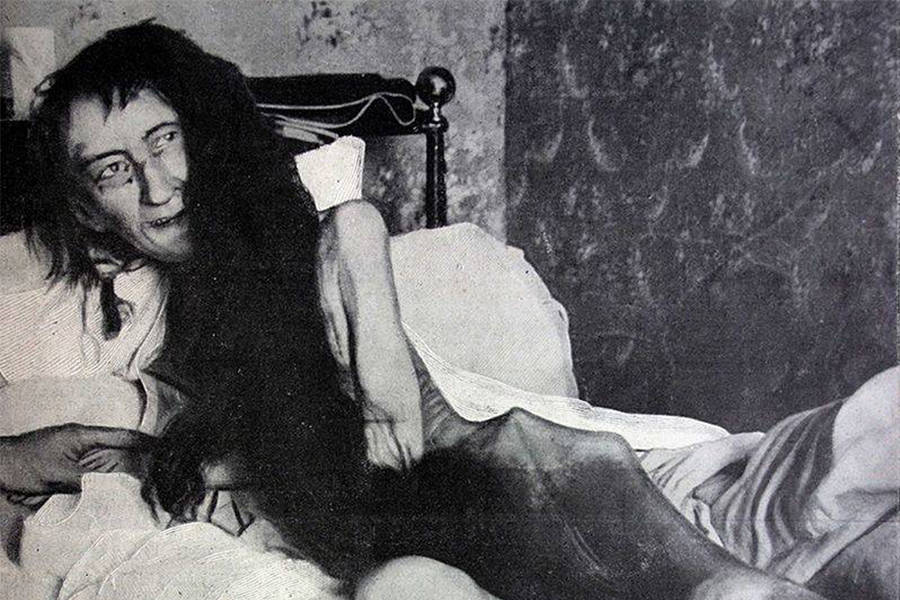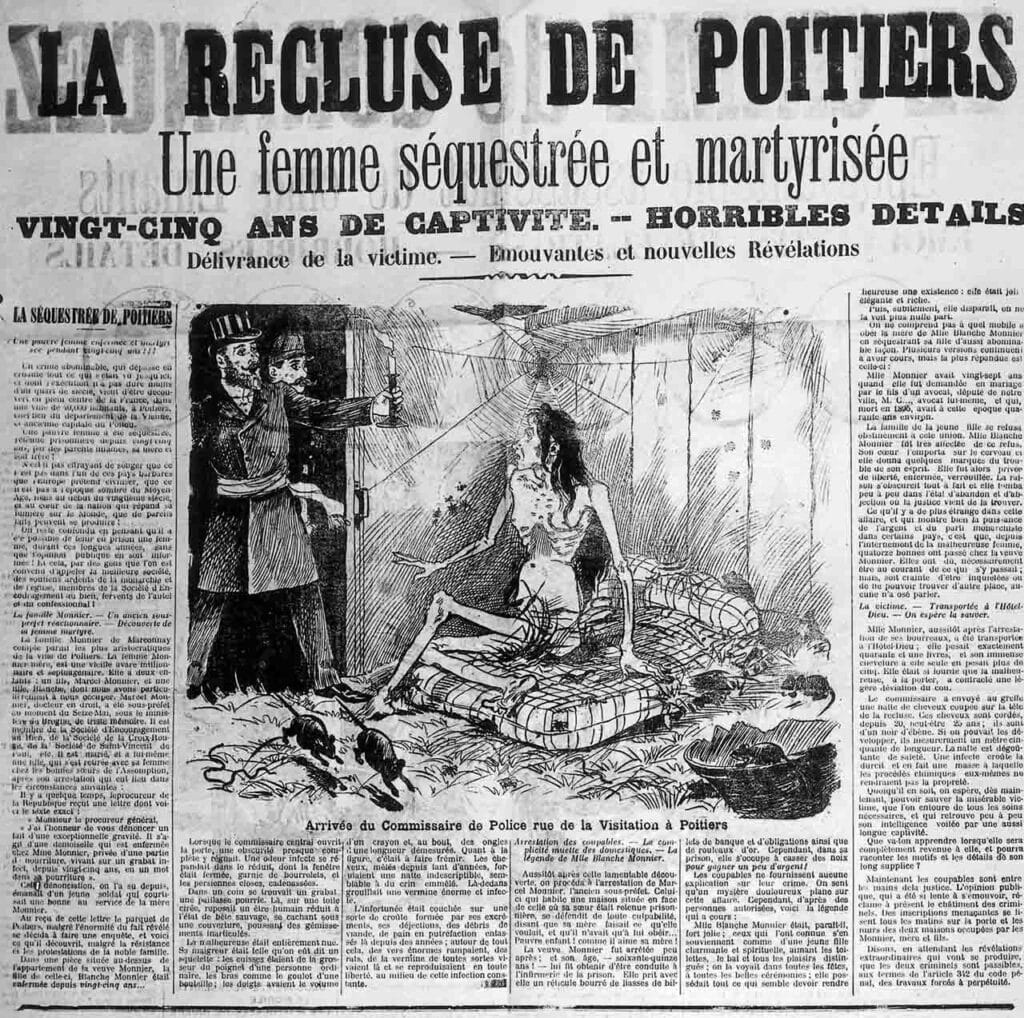Blanche Monnier, or the la Séquestrée de Poitiers (“The Confined Woman of Potiers”), was a French woman trapped in a tiny room for a quarter of a century by her socialite mother.
Few stories scandalized French society in the early twentieth century as much as Blanche Monnier, and rightfully so. How could a mother do the unthinkable over such a minor transgression as falling in love with the wrong person? [1]
Blanche Monnier’s Early Life
The Monniers were an upper-middle-class family of the minor aristocracy who hailed from Poitiers in western France during the nineteenth century.
Her father, Emile Monnier, was head of a local arts faculty and had earned a prestigious Committee of Good Works Award. This prize honored citizens in nineteenth-century France for displaying high virtues. Her mother Louise was a well-known French socialite, and the family had connections to high society in Paris.

Blanche’s early years were unremarkable, and she appears to have lived the life of any typical member of the French provincial upper class in the mid-nineteenth century. Photos of her in her early twenties attest to her beauty, with curly hair, fair skin, and big, bright eyes. Yet Blanche had a problem.
Falling in Love
Blanche had fallen in love, but with a prospective husband whom her family did not approve of, a poor lawyer without the kind of social status that matched that of the Monnier family.
Moreover, he was considerably older than her. This ill-starred romance was the cause of Blanche’s subsequent fate.
In 1875 or early 1876, Blanche’s mother Louise, to prevent her daughter from marrying the lawyer, and to get her to end the relationship, locked her in a room of the Monnier house and told her she would not release her until she agreed to stop seeing the lawyer.
Temporarily Confined
Little further might have come of it had Blanche relented and acquiesced to her mother’s demands. But she didn’t and as the days and then weeks went by, what had initially been an extreme measure to try to force Blanche’s hand transformed into something else.
Blanche’s friends and neighbors of the family wondered at the time exactly where the Monniers’ beautiful daughter had gone to, while Blanche’s lawyer lover must have also inquired after her.
Yet her disappearance was not brought to the attention of the authorities, and as time went by, her detention became permanent imprisonment.
More than Blanche’s mother was responsible for the crime. Her brother Marcel and father Emile were also involved, though Emile’s role in the affair came to an end when he died in 1879 after Blanche had already spent three or so years under lock and key.
Blanche’s Prison
Her imprisonment was brutal. The room she was kept in lacked sunlight as the window was blacked-out by shutters and the door locked from the outside.
Years later, the appalling condition her family kept her in would be revealed. But, as the years passed, the original purpose of Blanche’s imprisonment also faded away.
The lawyer who had been courting her died in 1885, about nine years into her imprisonment.
Why Blanche’s mother and brother continued her incarceration is something of a mystery, but it continued year after year.
Nobody seemed to be aware of what had happened, though years later, a neighbor would recount an incident in 1892 when they believed they had heard a woman shouting from the house.
Rescued At Last
Not everyone was seemingly unaware of Blanche’s predicament, and after twenty-five years of imprisonment, some unknown hero was her salvation. On May 23, 1901, the Attorney General of Paris received an anonymous letter which informed him of her captivity in the following fashion:
“Monsieur Attorney General, I have the honor to inform you of an exceptionally serious occurrence. I speak of a spinster who is locked up in Madame Monnier’s house, half-starved and living on a putrid litter for the past twenty-five years – in a word, in her own filth.”
Given the accuracy of the details provided, this individual, whoever he or she was, had witnessed Blanche’s captivity first-hand and seen the room where she was imprisoned, but the identity of the informant remains unknown to this day.
After received this letter, the authorities acted quickly. They proceeded to the Monnier house, where they searched the entire place, before coming to a padlocked room.
Breaking the door open, they entered into a scene of horror. There was no light, and before they could make out the full surroundings, they had to remove heavy, dust-laden curtains from a window that was shuttered tight and had to be broken open.
When it was, they saw that Blanche was there lying completely naked in a room full of filth. Fragments of food lay around the room, the air was putrid, and bugs were running around the place.
Blanche, who weighed just over 25 kilograms (55 pounds) at that point, was terrified by the appearance of people and the intrusion of the light.

After over twenty-five years of confinement, her mind was quite gone.
What Happened To Blanche Monnier and Her Mother
Blanche’s mother and brother were both arrested when the authorities had removed her from the vile prison. Her mother escaped lightly, given the severity of what she had done.
A baying mob gathered outside her house in the days that followed, and the combined stress of these events caused her to have a heart attack.

She was sent to a local infirmary, where she died 15 days later. Blanche’s brother Marcel was primarily mentally incapacitated himself. Although he was originally sentenced to 15 months imprisonment for his role in his sister’s imprisonment, he was acquitted on appeal and walked free from jail.
Blanche herself never fully recovered, though she made some limited progress. She lived for a further twelve years at a psychiatric hospital at Blois in central France, but there she was plagued by a range of psychological disorders, including anorexia, schizophrenia, and exhibitionism.
As if that wasn’t bad enough, her imprisonment had impacted her in many other ways. For instance, while she took great pleasure in bathing, something she had been denied for a quarter of a century, she had an aversion to intense light for the rest of her light.
She died on October 13, 1913, at the age of 64, having spent most of her adult life imprisoned or in a psychiatric hospital.
The Legacy of Blanche Monnier
Blanche’s story was retold and made more widely known in 1930 when André Gide, a French author and subsequently the recipient of the Nobel Prize for Literature in 1947, wrote about it in his novel La Séquestrée de Poitiers.
Here he changed little other than the protagonists’ names, the tale essentially being a reiteration of Monnier’s life story and her terrible fate.[2]
Gide’s retelling of Blanche’s story would influence Michel Foucault in the composition of one of his most significant works, Discipline and Punish: The Birth of the Prison.[3] As such, her terrible life story has had a considerable significance for twentieth-century French letters.
For similar stories, read about Fusako Sano or Junko Furuta
Sources
[1] The following is based on the following: ‘Blanche Monnier: The French Socialite Who Was Locked in Her Attic for 25 Years, Following a Thwarted Love’, in Vintage Daily News, June 7 2020; Benjamin Ivry and André Gide, ‘The Confined Woman of Poitiers’, in New England Review, Vol. 24, No. 3 (Summer, 2003), pp. 99–132; Emily S. Apter, ‘Stigma indelebile: Gide’s Parodies of Zola and the Displacement of Realism’, in Modern Language Notes, Vol. 101, No. 4, French Issue (Sep., 1986), pp. 857–870.
[2] André Gide, La Séquestrée de Poitiers (Paris, 1930); Edmund White, André Gide: A Life in the Present (Harvard University Press: Cambridge, Massachusetts, 1998).
[3] Michel Foucault, Discipline and Punish: The Birth of the Prison (New York, 1977).
- Tulip Mania – The Story of One of History’s Worst Financial Bubbles - May 15, 2022
- The True Story of Rapunzel - February 22, 2022
- The Blue Fugates: A Kentucky Family Born with Blue Skin - August 17, 2021